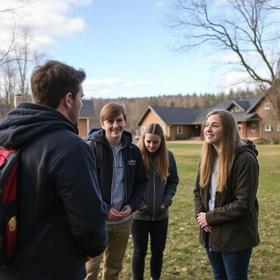When traditional school options and outpatient supports no longer feel enough, a therapeutic school can emerge as a viable—and sometimes essential—choice. This 2025 update examines what a therapeutic boarding school is, how the therapeutic school model has evolved, key data on tuition, demographics and outcomes, and questions families should be asking. As you explore whether a therapeutic school is the right move, you’ll find inside insights from industry experts, real-world examples, and links to trusted resources.
What Is a Therapeutic School?
A therapeutic school—often referred to as a therapeutic boarding school or residential treatment school—combines academic instruction with intensive emotional, behavioural and mental-health support. Licensed therapists, educators and residential staff work together to create a structured environment. Students receive individualized counseling, group therapy, life-skills programming and experiential activities (such as equine therapy or wilderness curricula) while also progressing academically. Wikipedia+2BoardingSchools.US+2
Unlike traditional day schools or typical boarding schools, therapeutic schools embed therapeutic supervision within the daily residential and academic schedule. The goal is broader than academics alone—it includes personal growth, emotional healing and social reintegration alongside educational progress.
What Makes the Model Relevant in 2025?
In recent years the therapeutic school sector has experienced shifts reflecting broader trends in adolescent mental health, post-pandemic stress, and evolving regulatory expectations. A 2024 “state of the union” review of therapeutic programming predicted higher levels of mental-health needs among adolescents, increased attrition at traditional schools, and a corresponding growth in demand for more intensive or “longer runway” environments.
Moreover, the membership association NATSAP (National Association of Therapeutic Schools and Programs) now requires member programs to hold accreditation from a recognised national therapeutic accrediting body. This is a key quality indicator. natsap.org
For families, the takeaway is this: if your child is showing persistent or escalating behavioural, emotional or academic problems that aren’t resolved through standard supports, the therapeutic school option deserves consideration now more than ever.
Key 2025 Data: Costs, Demographics and Program Updates
Tuition and cost range – Many therapeutic boarding schools continue to exceed $50,000 per year in total cost when combining tuition, board, therapy and residential care. Families must inquire carefully about what is and is not included in advertised costs.
Demographics and demand – Data from directories such as Niche show over 100 therapeutic-school listings in the United States, many of which are private, boarding or residential. Demand remains strong, driven by a broadening range of needs—from ADHD and academic under-achievement to trauma, substance misuse and attachment issues. Accio
Program structure and credentials – Schools emphasise credentialled clinical staff, low student-to-therapist ratios, and after-care planning. When reviewing a therapeutic school, families should ask about accreditation, staff qualifications, and how the therapeutic and academic arms work together. BoardingSchools.US+1
Outcomes and transparency – While rigorous longitudinal outcome data remains limited across the sector, the trend is toward greater transparency. Many programs now publish metrics on referral sources, lengths of stay, completion rates and post-program transitions (e.g., return home, return to traditional school, or move to college).
Admissions and fit – Therapeutic schools emphasise matching the student to the program mission. As predicted in 2024, many programs are seeing increased demand for admission assessments and more complex students.
In short, the landscape in 2025 is evolving toward more accountability, better accreditation and clearer fit-matching, but costs and variability remain high, making rigorous due diligence essential.
When a Therapeutic School Might Be the Right Choice
Consider a therapeutic school if one or more of the following apply:
Your child’s emotional or behavioural challenges (e.g., self-harm, aggression, substance use, trauma) have not responded to outpatient or day-school interventions.
Academic decline is severe and ongoing, and your child cannot keep pace in a standard setting even with support.
Safety concerns or family conflict are significant enough that a fully residential therapeutic environment is required.
You need a program that integrates therapy, education, and residential life under one roof, rather than cobbled-together services.
You are willing to engage as a family, because the best therapeutic school models include strong family therapy, regular communication and an after-care plan for reintegration.
According to Embark Behavioral Health, therapeutic boarding schools often serve as a “step-down” from higher-intensity residential treatment, but they also function as primary placements for adolescents requiring sustained structure and support. Embark Behavioral Health
When It Might Not Be the Best Fit
A therapeutic school is not a first-line option. If issues are mild, day-school extensions, intensive outpatient programs or local therapeutic school-day may suffice. Also note: Not all therapeutic schools are equal—differences in staff credentials, licensing, academic accreditation and after-care may vary substantially.
If your teen is primarily struggling with social adjustment, course-specific learning issues, or motivated to stay integrated in their current home community, then exploring less-intensive options is advisable first.
Questions to Ask When Evaluating a Therapeutic School
To determine whether a particular therapeutic school is right, ask:
Accreditation and licensing: Is the academic program accredited? Are therapists licensed? Is the program part of NATSAP or a similar body?
Therapeutic-academic integration: How do the academic schedule and therapy schedule work together? How often do therapists and teachers meet?
Student-to-staff ratios: What is the average daily ratio of residential staff to students? What is the ratio of therapists to students?
Program length and outcomes: What is the typical stay? What percentage of students complete the program and transition to return home, continue schooling or go to college?
Safety and emergency procedures: What are residential supervision protocols? How are risks managed?
Family involvement and after-care: How often are families involved in therapy? What is the re-entry or after-care plan when the student leaves?
Cost and what it includes: Does tuition include therapy, lodging, meals, academic materials, family sessions, transport? Are there hidden fees?
Fit for your child’s specific needs: Does the program specialise in the particular clinical profile your child has (trauma, substance use, mood disorder, etc.)?
Real-World Example
Take the case of “Alex,” a 16-year-old who had repeated suspensions in his local school due to defiant behaviour and escalating substance use. Outpatient therapy and a day-school placement failed to stem the decline, and his academics fell behind significantly. With collaboration between family, therapists and admissions, the family chose a therapeutic boarding school specialising in adolescents with behavioural and substance-use challenges.
Over a 10-month stay, Alex attended daily group therapy, individual sessions twice weekly, family therapy bi-weekly, and completed a full high-school curriculum accredited for transfer. His residential staff helped him rebuild structure and accountability; his family repaired communication through the family sessions. At discharge the school provided a detailed after-care plan and linked him with a community program at home. One year later, Alex is enrolled in a local day-school, his grades recovering and his substance use in remission.
This example illustrates how the therapeutic school model can provide a “reset” environment when less-intensive interventions have reached their limit.
How to Use This Guide in Your Decision-Making
Becoming well-informed is one of the most powerful steps. Start by:
Listing the specific behavioural, emotional and academic challenges your child is facing, and mapping what has been tried so far.
Visiting or interviewing multiple therapeutic programs, comparing differences in mission, staff credentials and after-care planning.
Consulting a third-party educational or therapeutic consultant if needed.
Reading profiles and reviews of schools on sites such as the BoardingSchoolReview blog (where this update appears) and related directories.
Considering budget and insurance: asking whether your health insurance covers therapy in residential settings, what the out-of-pocket cost might be, and if sliding-scale or financial aid is available.
Ensuring you understand the family commitment: therapy can extend beyond the student’s stay, and success often depends on strong family involvement during and after.
Conclusion
A therapeutic school can be a vital option when your child’s challenges go beyond what traditional schools and outpatient supports can address. The 2025 landscape offers stronger accreditation standards, heightened expectations for transparency, and a greater focus on matching students to mission-appropriate programs.
That said, the decision is significant—financially, emotionally and logistically. As you explore whether a therapeutic school is what you need, keep focused on fit, outcomes, cost, and long-term support. By doing so, you’ll be better equipped to decide whether a therapeutic school is the place where your child can heal, grow and succeed academically and personally.
For further reading, consult the BoardingSchoolReview blog’s full article on this topic and the NATSAP website for accreditation standards. Effective decisions begin with informed ones.















